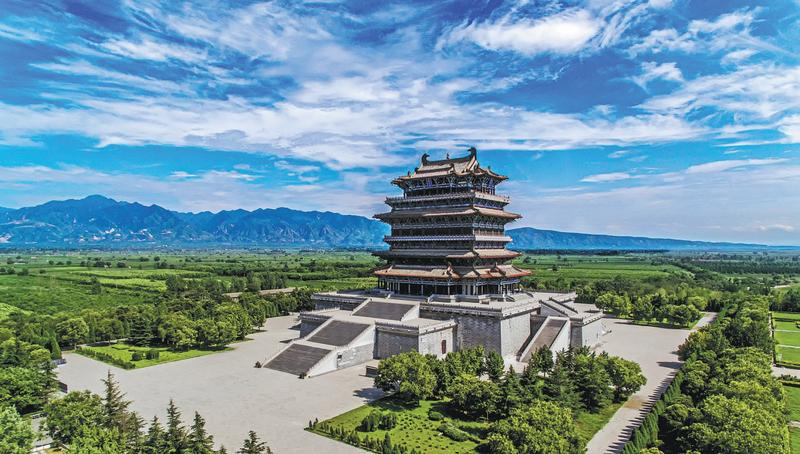History buffs flock to giant structure to take in breathtaking views
 Stork Tower is a landmark attraction in Yongyi city because of a much cited poem written by poet Wang Zhihuan. (HU ZENGCHUN / FOR CHINA DAILY)
Stork Tower is a landmark attraction in Yongyi city because of a much cited poem written by poet Wang Zhihuan. (HU ZENGCHUN / FOR CHINA DAILY)
There have been few poets in China that have become famous from just one or two pieces of work.
Tang Dynasty (618-907) poet Wang Zhihuan, is one of them.
He was not a productive poet, as only six of his poems were recorded in the Complete Collection of Tang Dynasty Poems. However, he became a household name because of his much cited work, Ascending Stork Tower:
The setting sun beyond the mountains glows,
The Yellow River seaward flows.
One can enjoy a grander sight,
By climbing onto a greater height.
Wang was a native of North China's Shanxi province, and this poem helped Stork Tower in the Shanxi city of Yongji become a renowned attraction.
Stork Tower, also known as Guanquelou in Chinese, is widely recognized as one of the nation's top four ancient towers along with Yellow Crane Tower in Wuhan, Hubei province; Tengwang Pavilion in Nanchang, Jiangxi province; and Yueyang Tower in Yueyang, Hunan province.
Historical records show this tower by the Yellow River was first built during the Northern Zhou Dynasty (557-581) but collapsed during the Jin Dynasty (1115-1234).
Reconstruction of the tower began in December 1997 and it opened to the public in September 2002.
Huang Xuxiang, a tourist from Shaanxi province, visited the tower in early January.
He said he was very eager to climb the tower because he wanted to see the setting sun above the Yellow River and experience the same emotions as the poet.
"Ascending a tall building gives various experiences and emotions to the climbers at different periods of time," Huang said.
"In a period of conflicts and wars, ascending a tower gave one a feeling of homesickness as there might be small hope of returning home. This was the emotion expressed by poet Wang Can in the late Eastern Han Dynasty (25-220) and early Three Kingdoms Period (220-280).
"But in a period like the early and middle Tang Dynasty, when people were confident and inclusive, ascending a tall building gave people a sense of loftiness and transcendence," Huang said.
According to a tour guide at the Stork Tower scenic area, the tower was originally built by Yuwen Hu, a general of the Northern Zhou Dynasty, as a watchtower for the purpose of defense.
During the following Sui (581-618) and Tang dynasties, the tower was no longer used as a military facility. Instead, it became a habitat for storks and other birds and earned its name for that reason.
Historical records show the original tower was 20 to 30 meters tall. However, as the highest point on the plain along the Yongji section of the Yellow River, it became an attraction favored by many poets and writers, who dedicated their poems and prose to praising the spectacular views provided by the tower.
The original building stood for almost 700 years, until it was destroyed by the invading Mongolians led by Genghis Khan in 1222.
The other three of the top-four ancient towers suffered the same fate. All were destroyed in the previous centuries.
Following the reconstruction of the Yueyang and Yellow Crane towers as well as Tengwang Pavilion, locals in Yongji and Shanxi strongly appealed for the rebuilding of Stork Tower.
The new tower, completed in 2002, is a nine-story building with a height of 73.9 meters, making it an imposing landmark along the Yellow River.
According to Li Guishun, a manager in charge of the reconstruction project, the new Stork Tower is the largest Tang-style structure in the country.
In addition, Tang Dynasty murals, which were collected from elsewhere in Shanxi and restored by experts from the National Cultural Heritage Administration, have been put on the interior walls of the tower.
"A tour of the tower is a trip back into the millennium-long history of the nation, where you can exchange with the great personalities of ancient China like Wang Zhihuan," Huang Xuxiang posted on his WeChat account. "And you are also in a process of sublimation with the boundless sights of the Yellow River and North China Plain before your eyes, and the infinite flow of history in the mind."
Li Yali contributed to this story.


